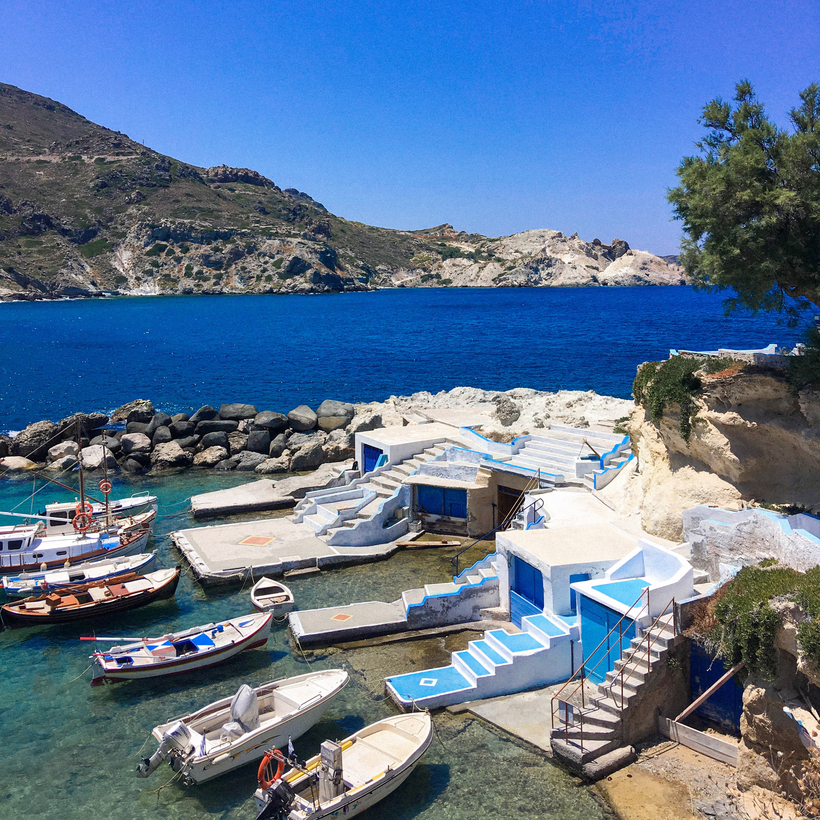After millennia of minding its own business, the Greek island of Mílos is having a moment. Travel + Leisure recently named it the top island in the world. Louis Vuitton has been filming ads there. Even Justin Bieber washed up on its shores earlier this year.
Now you can’t walk through the rustic fishing village of Pollonia without seeing a photo shoot taking place on the dock or visit the tiny hamlet of Mandrakia without dodging a queue of people lining up to pose with the picturesque bay in the background.
Yet all this attention comes as something of a surprise. Mílos is a far cry from the party island of Mykonos, or the swarming tourist caldera of Santorini. In fact, it’s a dusty backwater that’s a three-and-a-half-hour ferry ride from Athens or a 45-minute jump in a propeller plane. And by dusty, I mean dusty.

For close to 5,000 years the inhabitants of the island have dug it for its rich mineral deposits. Today, giant construction trucks roar down the winding roads, spilling their choking loads of kaolin and bentonite behind them, detritus that’s left over from the island’s crazy volcanic youth 90,000 years ago.
Industrial mining and luxury tourism have rarely gone hand in hand. The reasons for this are sound. When the north winds—the meltemi—blast across the island, one is given a thorough exfoliation by the island’s geology. On occasion someone gets a piece of grit in the cornea of an eye only to find out it’s a sliver of perlite—volcanic glass—that must be extracted with a needle.

What has attracted the high-fashion types to Mílos is not its rugged interior, nor its history. Sure, Mílos has catacombs—the most important outside Paris and Rome, residents say, although that’s a bit like being the third cola after Coke and Pepsi—and there’s a carefully restored amphitheater on a ghostly windswept hill. But when people rave about Mílos, it’s all about the beaches. With more than 70 of them dotting its circumference, the 12-mile-long island allows for maximum Instagram efficiency.
What better place to maintain one’s social-media addiction while constantly varying one’s backdrop? The smooth moonscape of Sarakiniko is just 20 minutes on your ATV from the green-and-pink-colored cliffs at Paliochori, which in turn are just down the dirt road from the caves and arches at Kleftiko. Indeed, Mílos’s beaches are so photogenic that even the inevitable bits of plastic waste seem more attractive than those found on other islands: little jolts of eye-catching polyethylene framed against the black, gray, and yellow sands.
So the Instagrammers come and go, moving ever onward from one to the next, like itinerant actors with only one line to say. Perhaps it was fated that they should have been drawn to Mílos. After all, one of the first minerals to be mined on the island was obsidian, which was used to make mirrors. What’s more, the recent mechanized mining has terraced the island’s ancient mountains and turned them into mammoth convex amphitheaters, from which an invisible audience can stare out at the unwitting players below them.

As it happens, Mílos is the birthplace of perhaps the original Insta-celebrity. It was here, in 1820, that the statue known as the Venus de Milo was discovered before being whisked off to Paris. Endlessly memed in postcards, cartoons, and statuettes, her turning pose, skimpy clothing, and look of studied nonchalance are a master class in affectation, even if her arms have been rather savagely cropped by time.
When the meltemi blows and coats everything in a fine white crust, the Instagrammers are, for a moment, petrified themselves, like so many Venuses longing for eternity.
George Pendle is an Editor at Large for AIR MAIL


